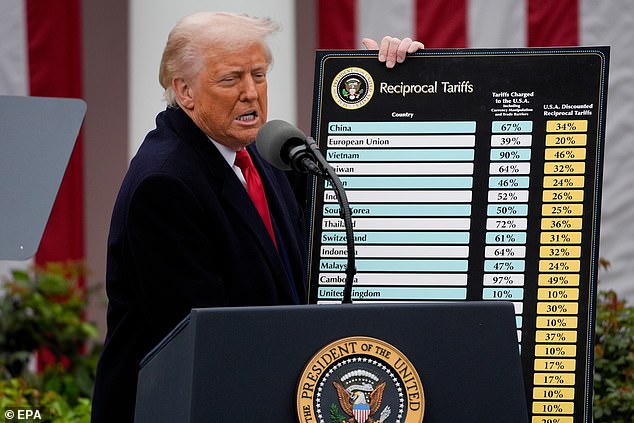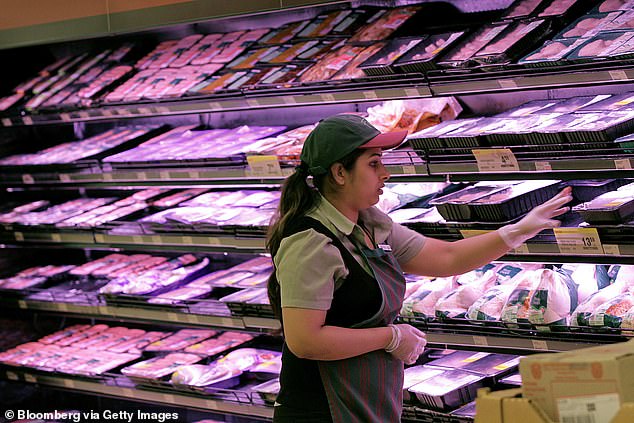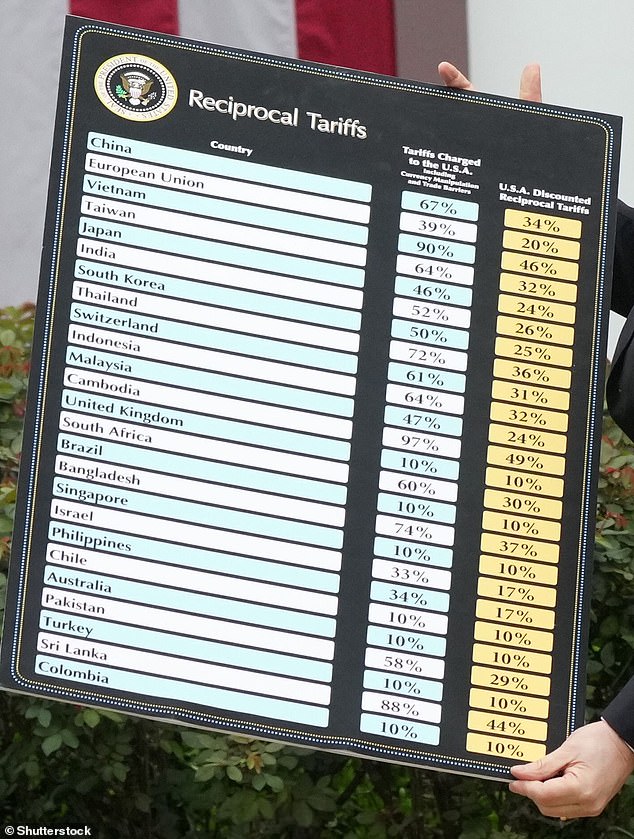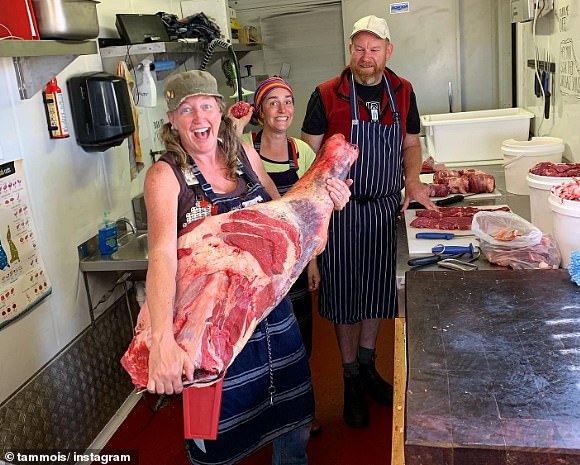- American tariffs might lead to higher costs for Australian consumers.
- PODCAST: An in-depth look at the controversy surrounding the war plans group chat, along with Trump’s reaction to his new portrait – all on Welcome to MAGAland. Tune in now.
Donald Trump The new 10 percent 'Liberation Day' tariffs imposed on Australian exports to the U.S. might ultimately lead to higher costs for local shoppers at grocery stores.
The U.S. president criticized Australia for not easing its stringent biosecurity regulations, which could have potentially exempted them from new reciprocal tariffs on their largest export to the United States, namely beef.
'Australia prohibits them—and they’re marvelous people, and remarkable in every way—but they prohibit American beef,' he stated.
'Nevertheless, we imported $3 billion worth of Australian beef from them solely last year.'
'They won't take any of our beef.
They aren't interested in it because they don't want it to impact their farming community, and honestly, I can understand where they’re coming from. However, as of midnight tonight, we will be implementing similar measures.
A kilogram of beef tenderloin costs Woolworths is currently priced at $28.
However, the Australian Food Sovereignty Alliance, which represents 350 small-scale farmers, is concerned that rump steak could end up priced at $56 for Australian consumers at grocery stores.

Tammi Jonas, a spokesperson for organic beef cattle production based in Daylesford, Victoria, stated that the new American tariffs on imported agriculture products will likely lead to increased purchases of Australian beef as nations seek alternatives to trade with the U.S.
"We have already established that there is significant global demand for Australian beef, and I believe this trend will only intensify," she stated to Daily Mail Australia.
In a worldwide supply shortage like this, we might witness rump steak prices surpassing $50 per kilogram.
'What you had wasn’t just a family dinner; it was an upscale luxury experience.'
Doctor Jonas mentioned that increased export prices could lead to fewer Australian meats being available for local consumers, particularly if the United States market were not an option.
"I'd say there's a good chance of that, indeed," she stated.
'Even if we still have an ample supply of beef sold within Australia , the prices are sure to increase.
'When operating in international markets, you have to navigate the fluctuations and if they can fetch a higher price abroad, they won’t lower their rates domestically.'

However, Angus Gidley-Baird, a senior analyst for animal proteins at RaboResearch, stated that premium steaks at grocery stores were improbable due to the robust supply of Australian beef following recent precipitation events.
"We generated all-time high amounts of beef production last year; therefore, I can’t comprehend why we'd face a scarcity in our local market leading to increased prices," he stated to Daily Mail Australia.
The exports serve as our markets where we channel the extra produce.
Australia has faced across-the-board 10 percent tariffs, aligning with countries like the UK, Singapore, Brazil, and Chile.
However, China faces a significantly higher tariff of 34 percent, whereas South Korea is subject to a 25 percent tariff and Japan to a 24 percent tariff.
According to Meat and Livestock Australia statistics, the United States became the largest importer of Australian beef in 2024, significantly outpacing Japan, South Korea, and China.
Out of the Australian beef exported to the U.S., 96 percent consisted of the leaner, grass-fed type, which was delivered either chilled or frozen.
Many Americans have been facing a prolonged dry spell, resulting in much of their beef being more fatty and grain-fed.

Beef suppliers from South America, namely Argentina and Brazil, are grappling with insufficient precipitation as well.
Similar to Australia, they would face 10 percent tariffs as well, indicating that other countries involved in beef production are experiencing comparable pressures.
"If we face a substantial tariff that applies universally, our competitive stance doesn’t change," stated Mr. Gidley-Baird.
On Thursday, The Australian Agricultural Company and Elders will likely encounter share market pressures.
Last year, Australian meat exports to the U.S. amounted to $4.2 billion, with approximately 400,000 tons of beef shipped to the American market.
Jessica Amir, a market strategist at Moomoo, stated that Australia's primary export to the U.S. faced significant danger.
"Donald Trump stated 'no more.' Just like that, it appears that Australia's largest export to the U.S. might be affected," she commented.
It seems that Trump might impose restrictions on importing Australian beef; however, nothing is confirmed until further details emerge.

Mr Gidley-Baird stated that despite any import duties, the Americans, who generate more fatty, grain-fed beef, would still require the leaner, Australian grass-fed beef for making hamburger patties.
"The United States still relies on imports due to insufficient domestic production," he stated.
They will still require Australian beef — despite the drought improving in the U.S., they've They sold off their livestock, and both herd size and output have decreased. .
What Australia exports to the U.S. enhances their production system because it adds balance to the more robust cattle they raise for burger making.
They require the product, and I'm among the largest suppliers of it—logically speaking, even with my rationale intact, I'd conclude that they would still make the purchase.
On the periphery, robust U.S. demand for grass-fed beef has driven up costs for Australian lean mince, which is currently priced at $15.50 per kilogram at Woolworths.
Mr. Gidley-Baird mentioned that the U.S. market has shown considerable strength, with high demand for products causing some upward pressure on minced meat and lean cuts' pricing.
The Australian Food Sovereignty Alliance has observed that mince prices have surged to over $36 per kilogram.
But Dr Jonas predicted tariffs on Australian beef would see American demand plunge, despite the fact they are in drought with an undersupply of grass-fed beef.
'"Both Americans and Australians are facing equally severe cost-of-living crises," she stated.'
The Australian Food Sovereignty Alliance did not conduct particular economic analysis regarding the impact on Australian beef prices due to the implementation of the Trump administration's agricultural tariffs set for Thursday.
However, it contended that China experienced an outbreak of African swine fever in 2019. resulted in pork prices being doubled, As supplies decreased by 40 percent.
The coalition fights against major agricultural corporations such as JBS Foods Australia, which controls feedlots and slaughterhouses.
Dr. Jonas mentioned, "The nearby farmers and I are being denied access to the slaughtering facilities."
Although this seems beneficial for Australia—when we consider the idea of increasing exports—the truth is that only a small number of individuals benefit from these higher exports.
The recent 'Liberation Day' tariffs imposed on Australian agricultural and pharmaceutical products come after the 25 percent duties levied on steel and aluminum, which were implemented on March 12.
Read more
Out Of Topic Show Konversi KodeHide Konversi Kode Show EmoticonHide Emoticon